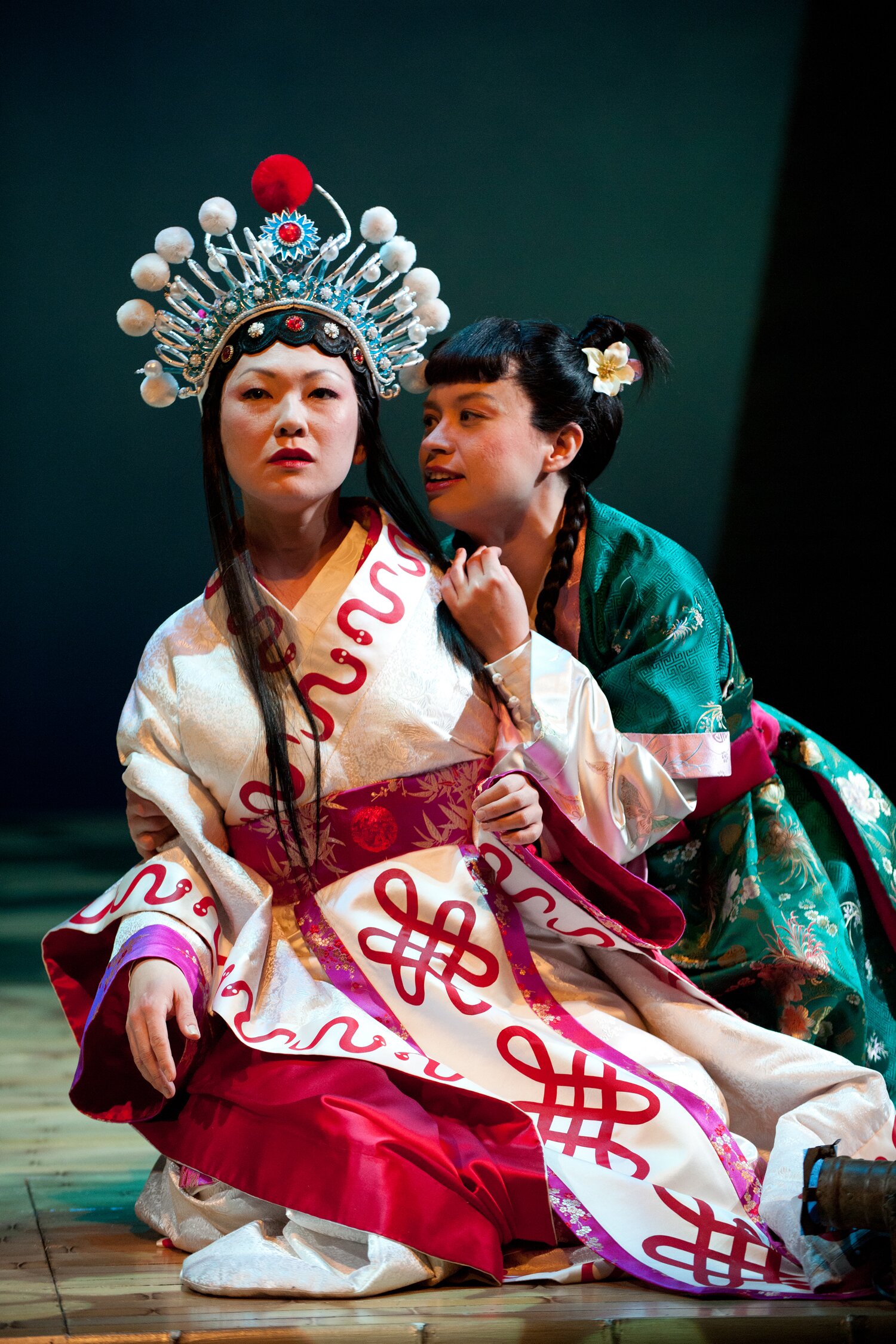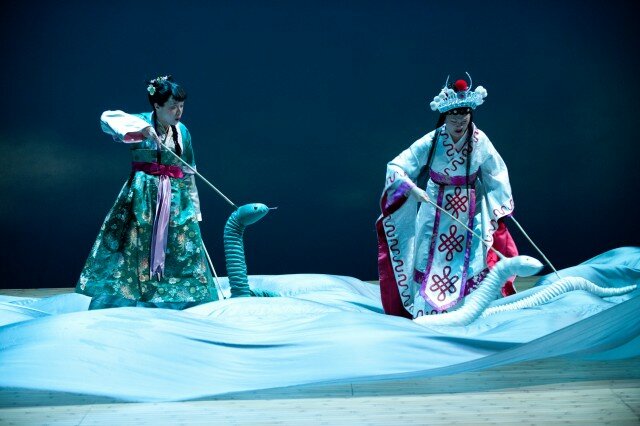
After two gorgeous days at the Oregon Shakespeare Festival–Day One and Day Two–I was ready for an adaptations day in the theatre, beginning with Mary Zimmerman’s The White Snake and ending with a new translation of Chekov’s Seagull.
Recently, there’s been a theatre trend of producing retellings or reworkings of old stories. Perhaps, it’s not a new trend, but as it flows in and out of fashion, the retellings that shouldn’t happen are easily spotted. And then, there’s Mary Zimmerman, who’s known for a number of truly compelling pieces of theatre, including Metamorphosis and Arabian Nights.
Zimmerman goes into a rehearsal room with her chosen artists (actors, designers, dramaturgs) and says, “Let’s do a show about x,” and based off their rehearsals she goes home and writes the script (yes, I’m madly in love). And this is how White Snake (through July 8; tickets) came about at OSF on the Angus Bowmer stage.
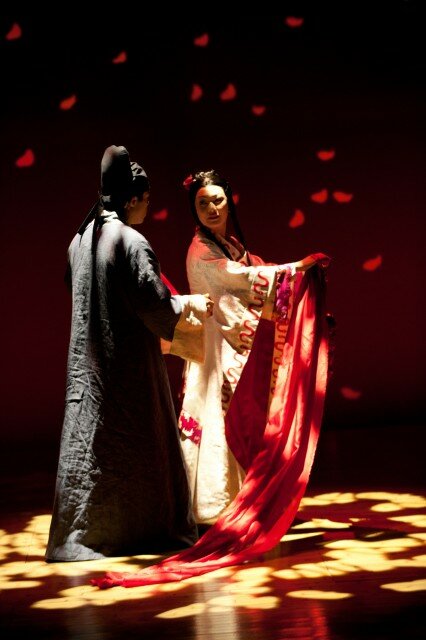
The White Snake is a retelling of a folktale from China that has a few derivations (all of which were used for the production). Essentially, the White Snake (played by the exceptional Amy Kim Waschke) is the spirit of a snake who has been studying for many years on a mountain. She knows so much she can actually transform her shape into that of a human.
One day, she and her best friend, the Green Snake (Tanya McBride–I want her to be my best friend too), decide to take a field trip down to see the humans, just for fun. While there, it begins to rain and a young man named Xu Xian (the charming and handsome Christopher Livingston) offers his umbrella to the White Snake. Naturally, this makes her fall in love with him and they get married and pregnant in short order.
But not all are happy. The evil, bigoted Fa Hai (the believably wicked Jack Willis) doesn’t think snake spirits and humans should be together. Oh, and she forgot to mention she was a snake spirit, so Xu doesn’t know. Fa Hai tries to tear the couple apart (cue James Dean in Rebel Without a Cause).
What was most appealing about this folktale were the many interpretations of the White Snake as a character in legend. She could be good or evil. Corrupter or innocent. *cough* Virgin or whore *cough*. As I said, the production attempts to show you all possible roads. We do see White Snake’s power and her kindness along with her ability to destroy and love.
The staging of this piece was magical. Yes. Okay. Yes. It was magical. I felt like a kid. I felt awed, in the Biblical sense of the word. I was transported and I liked it. I think I emoted in there.
Zimmerman and her amazing cast utilize silk and satins to illustrate rain, water, clouds, mountains. The audience audibly gasped when the rain fell as small pieces of light blue silks. They had puppets for the snakes but also used different-sized umbrellas for them as well. And there were masks for other animal spirits we meet later in the play. With minimal set (designed by Daniel Ostling) and props, the actors effectively built the stage with their story alone.
This particular matinee also had to deal with a bit of a glitch. The power went out in the middle of their show, and for maybe seven minutes they continued performing without the benefit of mics or stage lights. Though the actors handled it beautifully–they didn’t even pause when the lights went off in the theatre, but kept plowing through–it was an absolute shame because the lighting design (by T.J. Gerckens) was breathtaking.
I won’t ruin the ending for you, but it was powerful stuff. And though I only mention the leads in this review, I must say that the entire ensemble added something amazing to this piece. The story was well-crafted, poignant, funny, and at one point scary. If I was a person who cried– all right I can’t lie. I cried. A lot.
So after admitting that I have feelings (shut up, you’re not my real mom), I really wanted sushi. On the recommendation of an ex-intern at OSF, I went to Kobe.
Kobe is nestled down a flight of stairs to add that extra illusion of transporting to a new world, like Narnia or Hogwarts. Remember that babbling brook I mentioned? I ate dinner beside it on a patio. And while it looked majestic, the parking lot on the other bank ruined the illusion of being in Stratford-upon-Avon.
The meal came with a small bowl of edamame, which they made with some sort of magical truffle salt. And though it was a bit pricey ($11), my Tiger Roll managed to be both pretty and tasty.
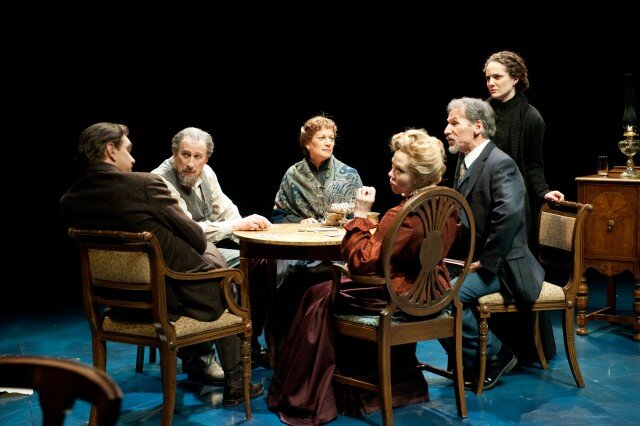
My trip to OSF comes to a close with Libby Appel’s adaptation of Chekov’s Seagull (through June 22; tickets), translated by Allison Horsley. What does a 100-year-old play written by a Russian man have to say to an audience here and now? A lot. Hear me out:
Chekov, though clearly writing from a place of privilege, captured the suffering of man in relation to art, love, and general nagging directionless feelings of wanting to be greater that one actually is. Back in November, Pony World compiled all of Chekov’s writings into a new play about the pains of working in an office called Suffering, Inc. If Chekov’s writing had not been so universal, that production would not have worked as well it did.
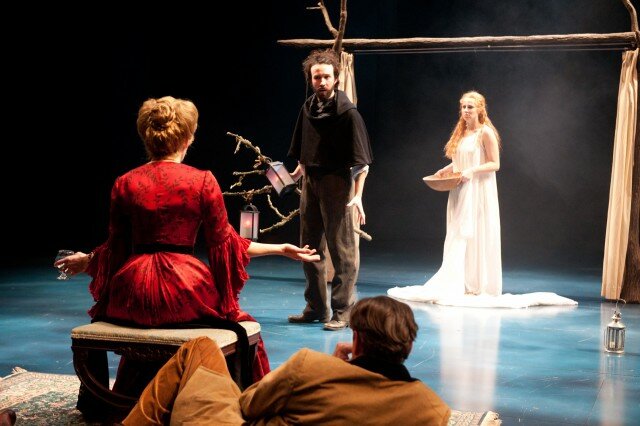
Seagull has no really likeable characters, and because it’s Chekov, there’s little-to-no action, but the weight these characters feel is still incredibly moving and heart-wrenching. Kate Hurster as the vodka-soaked, lovelorn Masha was beautifully poignant as she silently pined away for the distracted Kostya (Tasso Feldman). And Katheryn Meisle’s performance as the aging actress Irina was wonderfully, pathetically self-centered.
Like Troilus and Cressida, Seagull is in a difficult place. There aren’t many likable characters, but you are able to see yourself in them–I’m not sure I’d want to know someone who hasn’t questioned their direction in life or known public failure. Seagull shows us these things and makes them painful, amusing, and heartbreaking. Everyone in the play desires someone they can’t have, and all of them come at the idea of love very differently, almost selfishly. But you are compelled to watch on.
What was the most shocking to me was how much I laughed during this production. The last time I saw Seagull, there was not much laughter; the play piled on the shit and the shit kept coming. Strangely enough, that production was not as mesmerizing to watch as this one.
Thus ends my three-day adventure to OSF. There are five shows left in their season that haven’t even opened. Oh Ashland. You magical place of amazing theatre and fancy food I can barely afford. I miss you. Tell me you miss me too.
